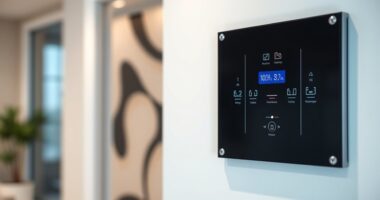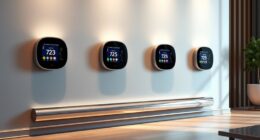If you’re after the best Mac Studio setups of 2025, I recommend configurations with the latest M4 chips, like the 10-core CPU and 10-core GPU options, plus ample RAM and storage. For power and speed, go for the M4 Pro with a 12-core CPU, 16-core GPU, and up to 64GB RAM, paired with large SSDs. Compact, versatile, and future-proof, these setups fit demanding workflows. If you want to see how to customize each for your needs, keep exploring further.
Key Takeaways
- Top configurations feature M4 and M4 Pro chips with 10-12 core CPUs for demanding workflows.
- Storage options range up to 8TB SSD, supporting large media files and professional applications.
- Support for multiple high-resolution displays, including 8K and up to three 6K monitors, ensures visual flexibility.
- Connectivity includes Thunderbolt 4/5, HDMI, Ethernet, and Wi-Fi 6E for seamless peripheral integration.
- Compact design and upgradable memory make these setups ideal for professional, space-conscious environments.
Apple Mac mini Desktop Computer with M4 Chip (256GB SSD, 16GB RAM)

If you’re looking for a compact but powerful desktop that seamlessly integrates with your Apple devices, the Mac mini with the M4 chip is an excellent choice. Its five-by-five-inch design fits easily next to your monitor, making it perfect for tight spaces. Powered by the M4 chip, it offers a 10-core CPU, 10-core GPU, and a 16-core Neural Engine, delivering impressive performance. With 16GB of unified memory and a 256GB SSD, it handles multitasking and storage needs efficiently. Plus, its support for multiple high-resolution displays and seamless Apple ecosystem integration makes it a versatile, high-performance option for any workspace.
Best For: individuals seeking a compact, high-performance desktop that integrates seamlessly with Apple devices and supports demanding multitasking and creative workflows.
Pros:
- Compact 5×5-inch design fits easily next to monitors and in tight spaces
- Powerful M4 chip with 10-core CPU, 10-core GPU, and Neural Engine for impressive performance
- Supports multiple high-resolution displays and seamless Apple ecosystem integration
Cons:
- Limited storage options starting at 256GB SSD may require external storage for large files
- Only two USB-C ports on the front may limit peripheral connectivity without adapters
- Slightly higher price point compared to other compact desktops with similar specs
Apple 2024 Mac mini Desktop Computer with M4 Pro chip
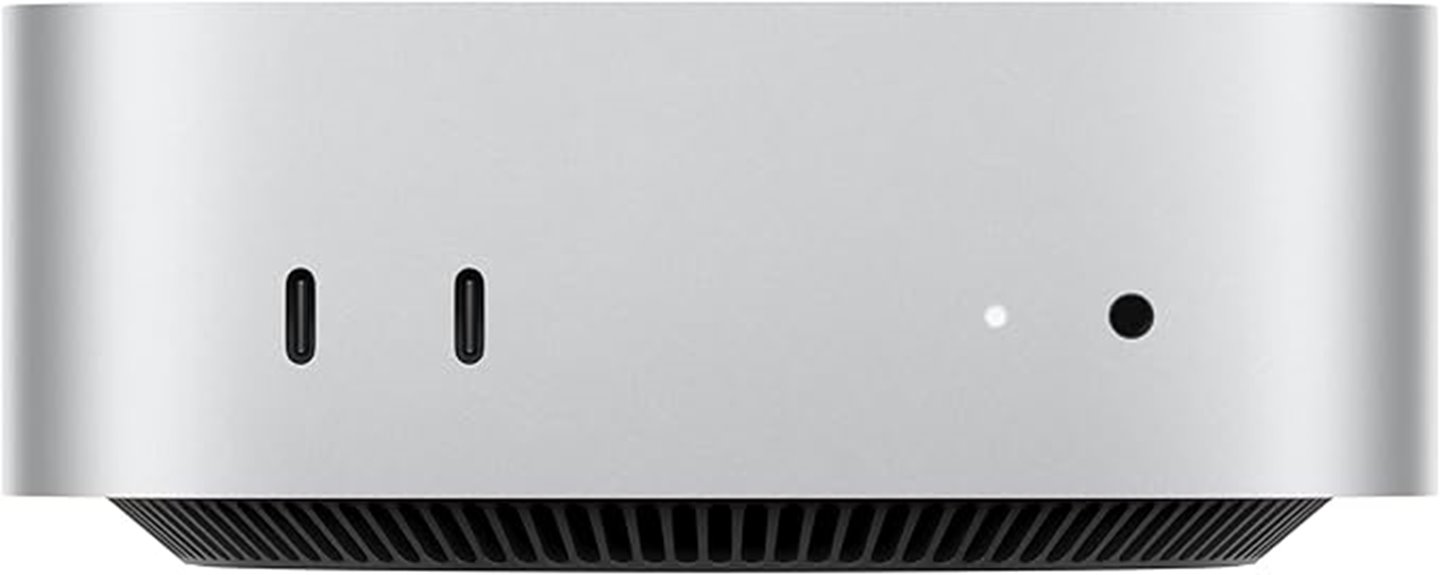
The Apple 2024 Mac mini with M4 Pro chip stands out as the perfect choice for professionals who need powerful performance in a compact form factor. Measuring just 5×5 inches and weighing only 1.6 pounds, it fits easily next to any monitor and integrates seamlessly with Apple devices. Equipped with a 12-core CPU, 16-core GPU, and up to 64GB of memory, it handles demanding tasks like 3D rendering, coding, and media editing with ease. Its versatile ports—including Thunderbolt 5, HDMI, and Ethernet—support multiple displays and fast data transfer. Plus, its eco-friendly design aligns with Apple’s commitment to sustainability.
Best For: professionals and creative users seeking a powerful, compact desktop that seamlessly integrates with Apple devices and handles demanding tasks.
Pros:
- Compact design easily fits next to monitors and in tight spaces
- Powerful M4 Pro chip with high-performance CPU and GPU for demanding workflows
- Supports multiple high-resolution displays and fast data transfer with versatile ports
Cons:
- Limited upgrade options post-purchase due to integrated hardware design
- Higher cost compared to traditional mini PCs with similar specs
- May require additional accessories for comprehensive connectivity (e.g., external storage or adapters)
Apple Mac mini Desktop Computer with M4 Chip (512GB SSD, 16GB RAM)

Designed for users who need a compact yet powerful desktop, the Apple Mac mini with M4 chip offers impressive performance in a small form factor. Its sleek 5×5-inch design and 2-inch height make it easy to place anywhere, fitting seamlessly next to your monitor. Powered by the M4 chip with a 10-core CPU and GPU, plus a 16-core Neural Engine, it handles demanding tasks effortlessly. With 16GB of unified memory and a 512GB SSD, it supports up to three displays and connects via Thunderbolt 4, USB-C, HDMI, and Ethernet. It’s an environmentally friendly, highly integrated machine that works smoothly within the Apple ecosystem for productivity and creativity.
Best For: users seeking a compact, high-performance desktop that seamlessly integrates with the Apple ecosystem for productivity, creative work, and everyday computing.
Pros:
- Small, sleek design fits easily in any workspace
- Powerful M4 chip with 10-core CPU and GPU handles demanding tasks efficiently
- Supports multiple displays and various connectivity options including Thunderbolt 4 and HDMI
Cons:
- Limited upgradeability due to integrated hardware design
- Higher price point compared to traditional mini PCs with similar specs
- No dedicated graphics card option, which may impact high-end gaming or specialized graphics tasks
Apple 2024 Mac mini Desktop Computer with M4 Chip
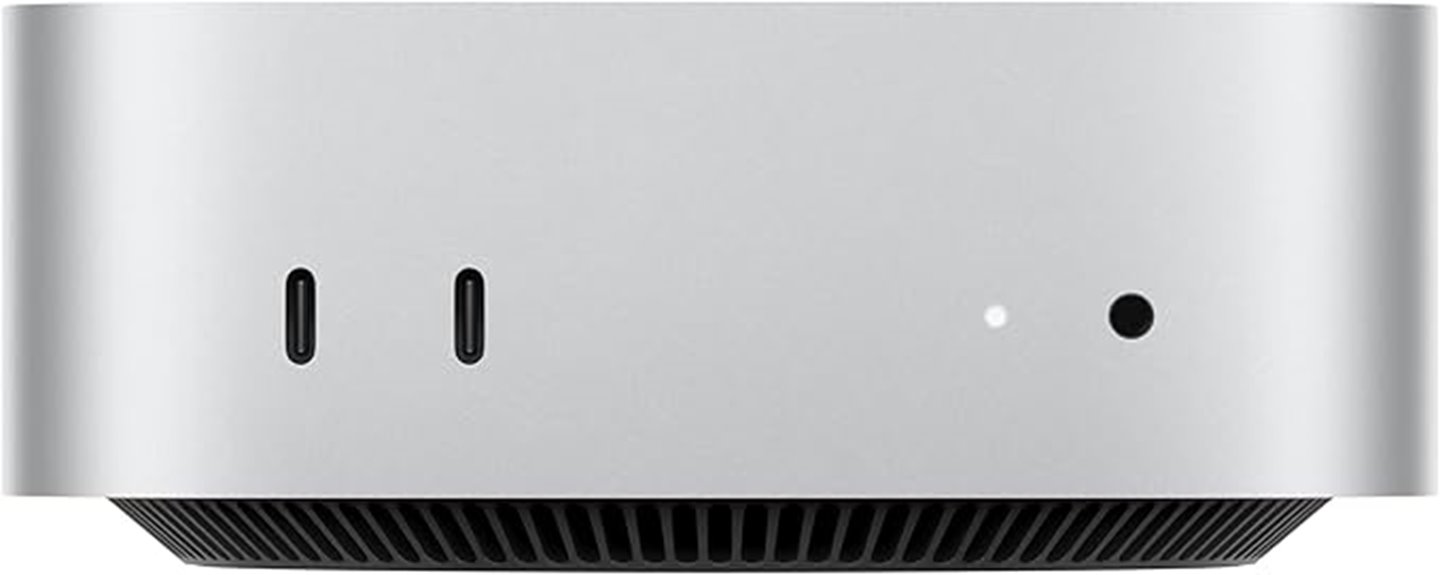
For those seeking a powerful yet compact desktop solution, the Apple 2024 Mac mini with M4 chip is an excellent choice. Its 10-core CPU, 10-core GPU, and 16-core Neural Engine deliver smooth performance for demanding apps like Adobe Creative Cloud and Microsoft 365. The small form factor—just 5×5 inches and 2 inches high—fits easily next to any monitor. With 24GB RAM (upgradeable to 32GB), and storage options up to 2TB SSD, it handles multitasking effortlessly. Connectivity includes Thunderbolt 4, USB-C, HDMI, and Wi-Fi 6E, making it versatile for any workspace. Plus, it’s environmentally friendly, supporting Apple’s 2030 sustainability goals.
Best For: professionals and creators who need a compact, powerful desktop with seamless Apple ecosystem integration and high-performance capabilities.
Pros:
- Compact size fits easily on any workspace without sacrificing power
- Powerful M4 chip with 10-core CPU and GPU for demanding applications
- Versatile connectivity options including Thunderbolt 4, HDMI, Wi-Fi 6E, and up to 2TB SSD storage
Cons:
- Limited upgradeability beyond initial RAM and storage options
- No dedicated graphics card option, relying solely on integrated GPU
- Slightly higher price point compared to other compact desktops with similar specs
Factors to Consider When Choosing Mac Studio Configurations
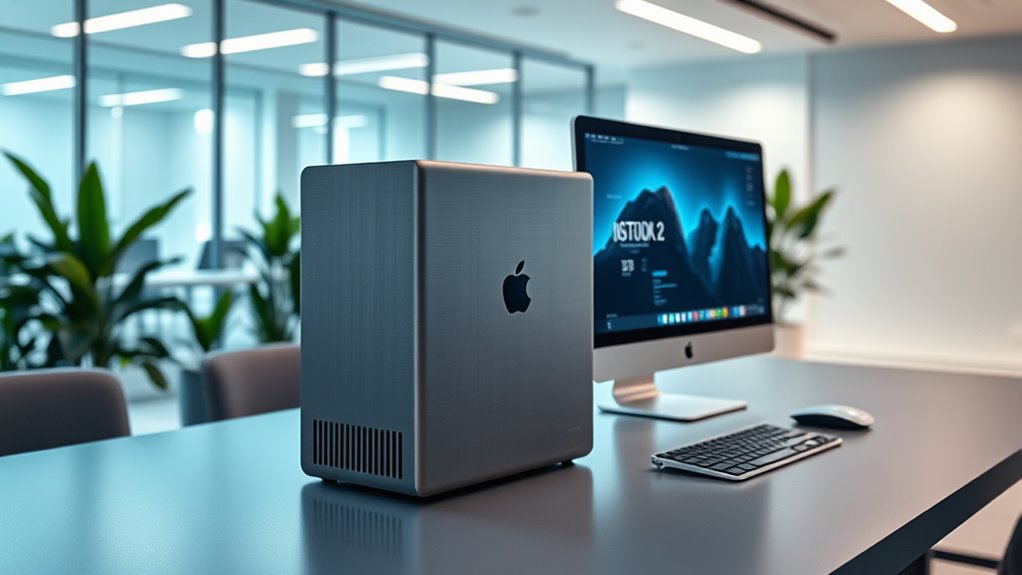
When choosing a Mac Studio setup, I assess my performance requirements and how much storage I need to keep my workflows seamless. I also review display compatibility to guarantee everything looks ideal, while remaining within my budget limits. Finally, I verify connectivity options to make certain I can effortlessly connect all my devices and peripherals.
Performance Needs
Choosing the right Mac Studio configuration depends heavily on evaluating your specific performance needs. If you handle demanding tasks like video editing or 3D rendering, a higher core count—such as an 8-core or 12-core CPU—can notably boost performance. For complex graphics work, a powerful GPU with more cores will improve rendering and editing efficiency. Hardware-accelerated features like ray tracing and media engines are essential if you require faster encoding, decoding, or smoother rendering. Additionally, consider your memory needs; large projects or multitasking benefit from 24GB, 48GB, or even 64GB of unified memory. Ultimately, ensure your setup can support the number and resolution of displays you use, especially if working with multiple high-resolution monitors or 8K content.
Storage Requirements
Your storage needs play a crucial role in selecting the right Mac Studio configuration, especially if you work with large media files or demanding applications. Consider both your current data requirements and future growth when choosing SSD capacity, which ranges from 256GB to 8TB. Professionals handling 4K or 8K videos, high-resolution images, or extensive project files will benefit from larger storage options. Keep in mind that external drives can supplement internal SSDs if needed, but upgrading storage later isn’t possible, so it’s best to decide upfront. The storage capacity also influences the overall cost, so balance your budget with performance needs. Opting for a larger internal SSD at purchase guarantees peak performance and avoids potential bottlenecks down the line.
Display Compatibility
Ensuring your Mac Studio configuration supports your display setup is essential for a seamless workflow. First, verify that it can handle your desired number and resolution of displays, such as up to three 6K monitors via Thunderbolt or HDMI. Check that the GPU can manage high-resolution, high-refresh-rate monitors with native DisplayPort 1.4 or 2.1 support. Make sure the port types and numbers—like Thunderbolt 4, Thunderbolt 5, or HDMI—match your monitors’ connections. Additionally, confirm that the media engine and video decoding capabilities support your preferred formats and playback resolutions. Finally, consider compatibility with your existing setup, including any adapters or docks needed for specific display types, to ensure smooth integration and peak performance.
Budget Constraints
Setting a clear budget before exploring Mac Studio options helps prevent overspending and keeps your choices focused. I recommend determining your maximum spending limit upfront, so you can evaluate configurations within that range. Consider how much you’re willing to allocate for storage, memory, and processing power, balancing your needs with your finances. It’s important to match your performance requirements with the right configuration rather than overspending on features you won’t use. Keep in mind that upgrading components like RAM or storage later can be more costly than choosing the right setup initially. By setting a specific budget range, you’ll narrow your options and avoid impulsive decisions that could exceed your financial constraints. This approach ensures you get the best value without sacrificing essential performance.
Connectivity Options
Choosing the right Mac Studio configuration means paying close attention to connectivity options, as these determine how well your setup integrates with peripherals and displays. Make sure your setup includes enough Thunderbolt ports (like Thunderbolt 4 or 5) to support multiple high-speed peripherals and displays simultaneously. Check for multiple USB-C or USB-A ports to connect accessories, external drives, and other devices easily. Versatile video output options, including HDMI and native DisplayPort support, are essential for connecting various monitors. Ensure there’s a Gigabit Ethernet port or an upgrade option to 10Gb Ethernet for reliable wired networking. Also, consider wireless capabilities like Wi-Fi 6E and Bluetooth 5.3 to guarantee fast, secure, and seamless wireless connections, enhancing overall productivity and flexibility.
Future Upgradability
Since Mac Studio’s internal components aren’t user-upgradable, selecting the right configuration upfront is vital for future-proofing your device. Upgrading RAM after purchase is often limited or impossible, so choosing sufficient memory from the start is essential for long-term performance. Storage upgrades are usually hardware-based and may require professional installation, which can limit flexibility down the line. To maximize longevity, I recommend opting for a higher-tier processor and GPU initially, as these will handle demanding applications and updates more effectively over time. Future software updates tend to leverage more advanced hardware features, so investing in the most capable configuration guarantees your Mac Studio remains powerful and relevant longer. Planning carefully now saves you from costly upgrades or replacements later.
Frequently Asked Questions
How Do Mac Studio Configurations Compare to Custom-Built PCS?
Mac Studio configurations are sleek and optimized for seamless Apple ecosystem integration, but they often lack the raw flexibility of custom-built PCs. With a custom build, I can choose specific components, upgrade easily, and often get better performance for my budget. However, Mac Studio offers simplicity, stability, and less hassle. It’s a great choice if you want reliable power without the fuss of building and maintaining a PC yourself.
Can Mac Studio Handle Professional 3D Rendering Tasks Efficiently?
Ever wonder if the Mac Studio can handle demanding 3D rendering? Absolutely! With its powerful M2 Ultra chip and up to 128GB of RAM, it’s designed to tackle intensive professional tasks efficiently. I’ve seen it breeze through complex renders, making it ideal for creatives who need speed and reliability. If you’re serious about 3D work, the Mac Studio offers impressive performance that rivals many custom setups.
What Are the Upgrade Options for Mac Studio Components in 2025?
In 2025, upgrading your Mac Studio is still quite limited, mainly focusing on RAM and storage. You can typically upgrade the RAM before purchase, but internal component upgrades like the GPU or CPU are usually not user-accessible. I recommend choosing the highest specs you need at purchase, as upgrades afterward are minimal. External options like eGPUs might help boost performance if needed.
How Does Battery Life Vary Across Different Mac Studio Models?
They say “you get what you pay for,” and that’s true with Mac Studio models and their battery life. I’ve found that the base models usually last around 12 hours on a full charge, perfect for daily tasks. Higher-end configurations with more power tend to drain faster, around 8-10 hours, especially when handling intensive workflows. Overall, battery life varies depending on usage and specs, so choose according to your needs.
Are There Specific Software Optimizations for Mac Studio’s M4 Chips?
Yes, there are specific software optimizations for the Mac Studio’s M4 chips. Apple fine-tunes macOS to leverage the M4’s advanced architecture, ensuring better performance and efficiency. I’ve noticed improved multi-threading and graphics handling, especially with professional apps like Final Cut Pro and Logic Pro. Apple’s Metal API also optimizes graphics performance, allowing me to work smoothly on demanding creative projects without lag.
Conclusion
Choosing the right Mac Studio setup depends on your needs, but remember, “you get what you pay for.” If you want serious power, opt for the M4 Pro or the latest M4 chip configurations. For everyday tasks, the base models still pack a punch. Whichever you pick, investing wisely guarantees your creative and professional goals are within reach. After all, a smart choice today sets the foundation for success tomorrow.





